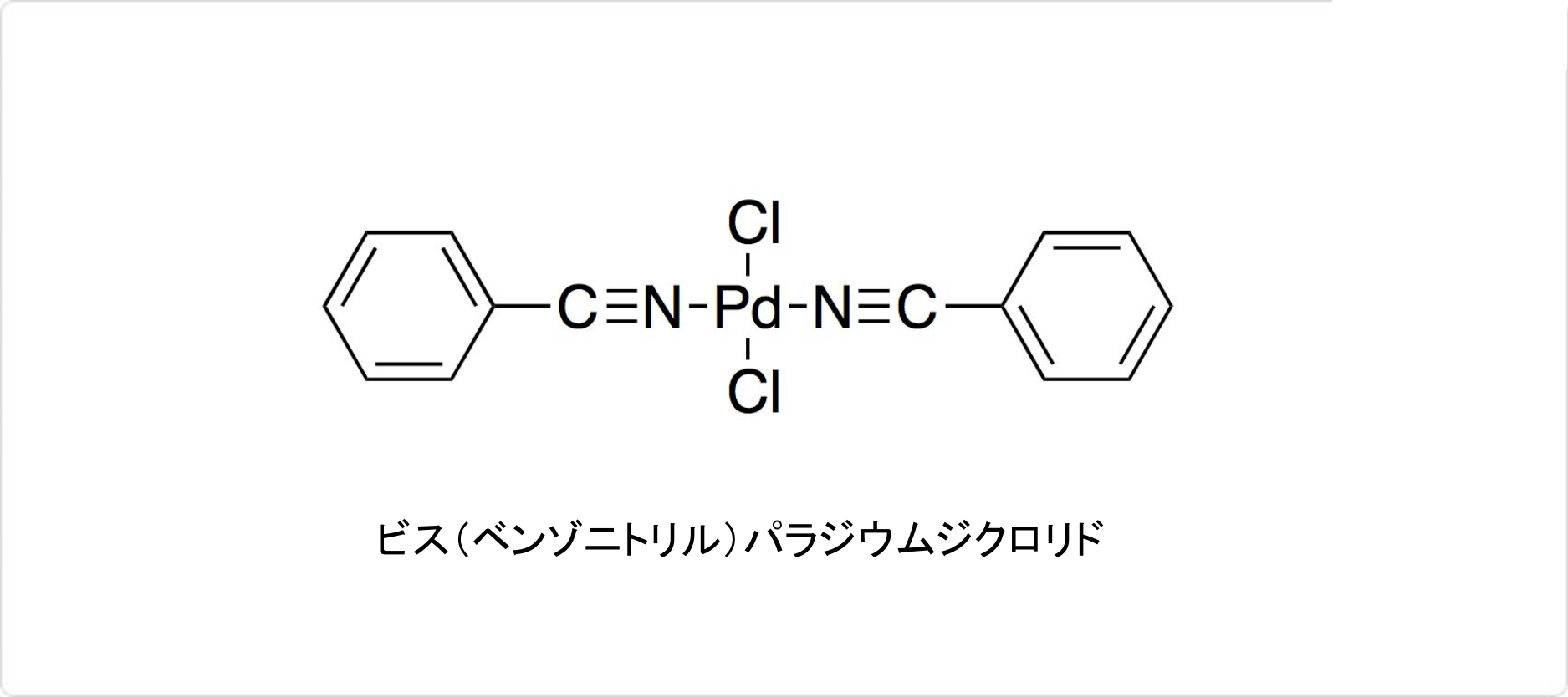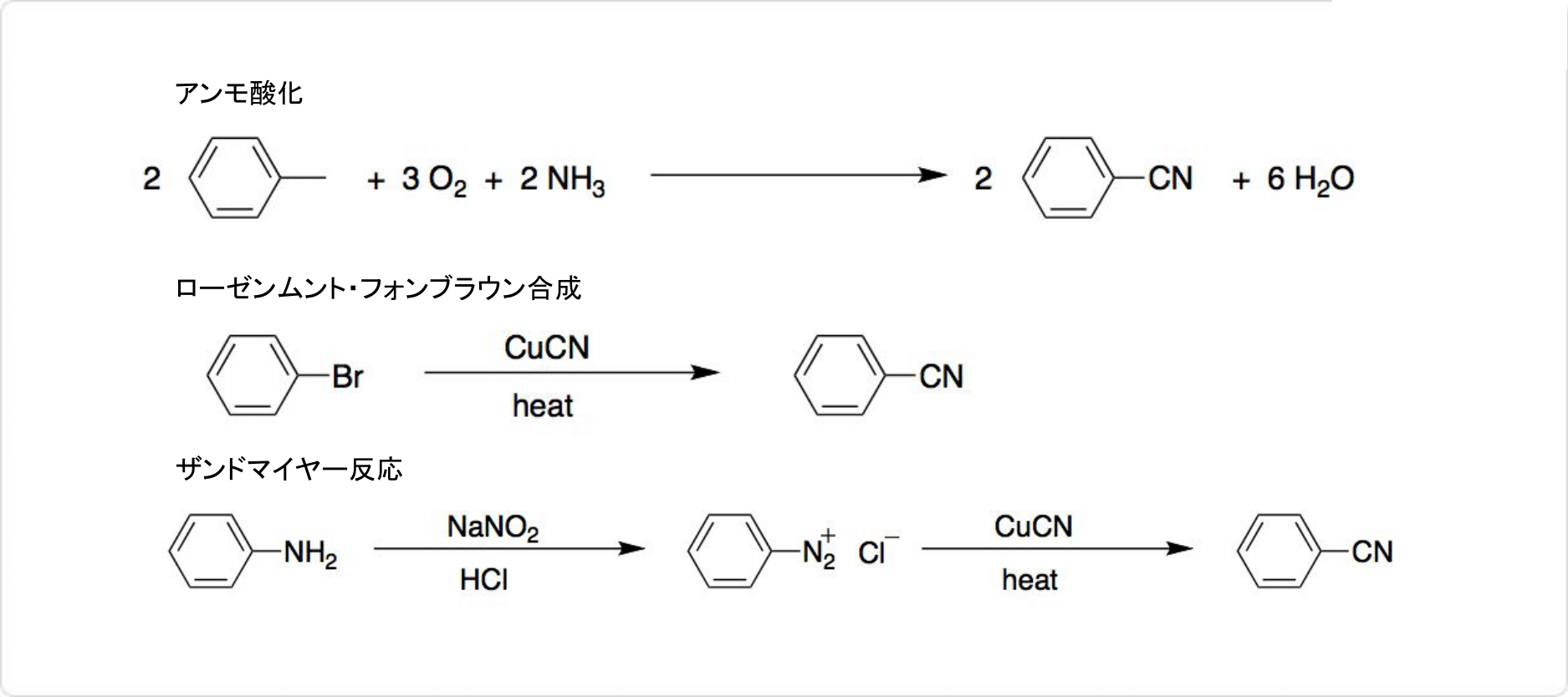ベンゾニトリル 化学特性,用途語,生産方法
外観
無色澄明の液体
性質
ベンゾニトリルの融点は−13°Cで、沸点は188〜191°Cです。25°Cで無色の液体状態として存在し、アーモンドに似た香りがあります。可燃性の物質で、引火点は75°Cで、発火点は550°Cです。
100°Cの水に対するベンゾニトリルの溶解度は1%です。アルコールやエーテルには任意の割合で混じります。
溶解性
水に微溶, 有機溶剤に可溶。エタノール及びアセトンに極めて溶けやすく、水に溶けにくい。
反応

図2. ベンゾニトリルの錯体
ベンゾニトリルは加水分解によって安息香酸になります。アミンと反応して、加水分解後にN-置換体のベンズアミドが得られます。臭化フェニルマグネシウムを反応させ、加水分解後にジフェニルケトイミン (Ph2C=NH) を生成可能です。
後期遷移金属とベンゾニトリルは、錯体を形成します。ベンゾニトリル配位子は強い配位子で容易に置換されるため、合成中間体として便利です。錯体の具体例として、ビス(ベンゾニトリル)パラジウムジクロリド (英: Bis(benzonitrile)palladium dichloride) が挙げられます。化学式はPdCl2(PhCN)2と表され、有機溶剤に溶ける黄褐色の固体です。ベンゾニトリルに塩化パラジウム(II) (PdCl2) を溶解させると調製できます。非配位溶媒中ではPdCl2に戻ります。X線結晶構造解析によると、2つのベンゾニトリル配位子はトランスに配置しています。
解説
ベンゾニトリル,液体.融点-12 ℃,沸点191 ℃,69 ℃(1.3 kPa).d1515 1.010.n20D 1.5289.エタノール,エーテル,ベンゼンに易溶.加水分解すればベンズアミドを経て安息香酸に,還元すればベンジルアミンになり,濃硫酸で重合させればトリアジン環を形成する.めっき溶媒,酸化防止用の溶剤として用いられる.また合成樹脂,染料,医薬品などの中間体である.[CAS 100-47-0]
森北出版「化学辞典(第2版)
用途
ベンゾニトリル(benzonitrile)は、芳香族化合物で、ベンゼンの水素原子の一つをニトリル基で置換した構造を持つ。
ベンゾニトリルは有用な溶媒で、多くの誘導体の前駆体でもある。
ベンゾニトリルは後期の遷移金属と配位錯体を作ることができる。ベンゾニトリル配位子は強い配位子によって容易に置換されるので、ベンゾニトリル錯体は合成中間体として便利である。
構造
ベンゾニトリルはの水素原子1つをシアノ基に置換した構造を有し、シアン化フェニルとも呼ばれます。化学式は省略してPhCNとも書かれます。モル質量は103.04g/molで、密度は1.0g/mlです。
製法
ベンゾニトリル,シアン化フェニルともいう.安息香酸のアンモニウム塩あるいはアミドを脱水すると得られる.工業的には,トルエンをアンモニアと空気で接触酸化するアンモ酸化法で製造される.
合成法

図1. ベンゾニトリルの合成
400~450°Cでアンモニアと酸素が反応して、トルエンのアンモ酸化 (英: ammoxidation) によってベンゾニトリルが合成されます。実験室ではベンズアミドやベンズアルデヒドオキシムの脱水によってもベンゾニトリルを生成可能です。
シアン化銅(I)やNaCN/DMSOとブロモベンゼンを使用したローゼンムント・フォンブラウン合成 (英: Rosenmund-von Braun synthesis) によっても、ベンゾニトリルは得られます。ローゼンムント・フォンブラウン合成とは、ハロゲン化アリールからアリールニトリルを合成する化学反応のことです。
アニリンをジアゾ化して、シアン化銅(I)と反応させてもベンゾニトリルが得られます。この反応はザンドマイヤー反応 (英: Sandmeyer reaction) と呼ばれます。
化学的特性
Bezonitrile is a colorless, oily liquid. It has a almond odor and a bitter taste. Slightly soluble in cold water, the solubility in water at 100°C is 1%; miscible with common organic solvents. When heated to decomposition, benzonitrile emits toxic hydrogen cyanide and oxides of nitrogen (HSDB 1988).
天然物の起源
Benzonitrile is reported to be found in natural cocoa aroma), in milk products, roasted filberts and peanuts and cooked trassi . Benzonitrile also has been detected in the thermal decomposition
products of flexible polyurethane foam.
使用
The most important commercial use for benzonitrile is the synthesis of benzoguanamine, which is a derivative of melamine and is used in protective coatings and molding resins. It is used intermediate for rubber chemicals; solvent for nitrile rubber, specialty lacquers, and many resins and polymers, and for many anhydrous metallic salts.
主な応用
Benzonitrile is a widely utilized as a solvent and an intermediate in industries making drugs, perfumes, dyes, rubber, textiles, resins and specialty lacquers. It finds application as a versatile precursor for many derivatives. It coordinates with transition metal to form complexes which act as synthetic intermediates.
製造方法
Benzonitrile can be prepared by following methods:
1) on a small scale by the dehydration in an inert solvent with phosphorus oxychloride or benzenesulfonyl chloride and an organic amine.
2) from benzoic acid by heating with lead thiocyanate.
3) by heating sodium benzenesulfonate with sodium cyanide.
4) by adding benzenediazonium chloride solution to a hot aq sodium cyanide solution containing cupric sulfate and distilling by ammoxidation of toluene.
Benzonitrile can also be produced in high yield by the vapor-phase catalytic ammoxidation of toluene.
定義
ChEBI: Benzonitrile is a nitrile that is hydrogen cyanide in which the hydrogen has been replaced by a phenyl group. It is a member of benzenes and a nitrile.
空気と水の反応
Slightly soluble in water.
反応プロフィール
The cyano group can be readily hydrolyzed in the presence of mineral acids to produce stable, moderately toxic benzoic acid . When heated to decomposition, Benzonitrile emits highly toxic fumes of nitrogen oxides and hydrogen cyanide [Sax, 9th ed., 1996, p. 353].
危険性
High toxicity; absorbed by skin.
健康ハザード
Benzonitrile may enter the human body by ingestion, absorption through the skin, or inhalation. The earliest symptoms of cyano compound intoxication may be weakness, headaches, confusion, and occasionally nausea and vomiting. The respiratory rate and depth will usually be increased at the beginning and at later stages become slow and gasping. Blood pressure is usually normal, especially in the mild or moderately severe cases, although the pulse rate is usually more rapid than normal.
火災危険
Special Hazards of Combustion Products: Toxic hydrogen cyanide and oxides of nitrogen may form in fire.
化学性质
甘い(アーモンド臭)臭気のある非水溶性液体。
使用用途
ベンゾニトリルは、 加水分解するとベンズアミドを経てに、還元するとに、濃硫酸で重合させればトリアジン環になります。多くの誘導体のであり、さまざまな業界や分野で溶媒や中間体として広く利用されています。
具体的な使用例を挙げると、プラスチック原料、酸化防止用の溶剤、めっき溶媒、建染め染料の合成原料、医薬・農薬中間体、エポキシ樹脂の硬化剤などがあり、非常に幅広い用途で使用可能です。
工業用途
Benzonitrile is used as an intermediate for rubber chemicals and as a solvent for
nitrile rubber, specialty lacquers, many resins, polymers and for many anhydrous
metallic salts (HSDB 1988; Hawley 1981). It is principally used as an intermediate
for benzoguanamine (HSDB 1988). It is also used as an additive in nickel-plating
baths, separating naphthalene and alkylnaphthalenes from non-aromatics by
azetropic distillation; as jet-fuel additive; in cotton bleaching baths; as a drying
additive for acrylic fibers; and in the removal of titanium tetrachloride and
vanadium oxychloride from silicon tetrachloride (HSDB 1988; Smiley 1981).
Benzonitrile is also used in perfumes at a maximum level of 0.2% in the final
product (Opdyke 1979).
安全性プロファイル
Poison by intraperitoneal andsubcutaneous routes. Moderately toxic by ingestion,inhalation, and skin contact. A skinirritant. Combustible liquid. When heated todecomposition it emits toxic fumes of CN
- and NOx.
代謝
Benzonitrile is mainly hydroxylated in vivo to cyanophenols, a small amount being
hydrolysed to benzoic acid (Williams 1959). Benzonitrile also forms 6>-hydroxybenzonitrile,
m-hydroxybenzonitrile, and /p-hydroxybenzonitrile in rabbits (HSDB
1988). In rabbit, 50% of a dose of 150 mg/kg was converted to conjugated
cyanophenols and 10% of the benzonitrile fed was excreted as benzoic acid.
Hydrogen cyanide is not a metabolite of benzonitrile (Williams 1959) and cyanide
was not found to be formed by benzonitrile either in vivo or in vitro (Tanii and
Hashimoto 1984). The in vivo microsomal hydroxylation of specifically deuterated
benzonitrile in the rat yielded mainly 4-hydroxybenzonitrile with 41%
retention of deuterium (Daly et al 1968).
輸送方法
UN2224 Benzonitrile, Hazard Class: 6.1; Labels:
6.1—Poisonous materials.
合成方法
トルエンを液相酸化して安息香酸を得たのちアンモニアで処理することにより得る方法がある。また、トルエンを直接アンモ酸化する(日本触媒法)ことによっても得られる。
純化方法
Dry benzonitrile with CaSO4, CaCl2, MgSO4 or K2CO3, and distil it from P2O5 in an all-glass apparatus, under reduced pressure (b 69o/10mm), collecting the middle fraction. Distillation from CaH2 causes some decomposition of benzonitrile. Isonitriles can be removed by preliminary treatment with conc HCl until the odour of isonitrile (carbylamine) has gone, followed by preliminary drying with K2CO3. (This treatment also removes amines.) Steam distil (to remove small quantities of carbylamine). The distillate is extracted into ether, washed with dilute Na2CO3, dried overnight with CaCl2, and the ether is removed by evaporation. The residue is distilled at 40mm (b 96o) [Kice et al. J Am Chem Soc 82 834 1960]. Conductivity grade benzonitrile (specific conductance 2 x 10-8 mho) is obtained by treatment with anhydrous AlCl3, followed by rapid distillation at 40-50o under vacuum. After washing with alkali and drying with CaCl2, the distillate is redistilled in a vacuum several times at 35o before fractionally crystallising several times by partial freezing. It is dried over finely divided activated alumina from which it is withdrawn when required [Van Dyke & Harrison J Am Chem Soc 73 402 1951]. [Beilstein 9 IV 892.]
不和合性
Incompatible with oxidizers (chlorates, nitrates, peroxides, permanganates, perchlorates, chlorine, bromine, fluorine, etc.); contact may cause fires or explosions. Keep away from alkaline materials, strong bases, strong acids, oxoacids, epoxides. They are incompatible Benzonitrile with acids; mixing nitriles with strong oxidizing acids can lead to extremely violent reactions.
廃棄物の処理
(1) Mix with calcium hypochlorite
and flush to sewer with water or (2) incinerate.
ベンゾニトリル 上流と下流の製品情報
原材料
準備製品
(ジフェニルメチレンアミノ)酢酸エチル
ベンゾグアナミン
α-シアノ-3-フェノキシベンジル=2,2-ジクロロ-1-(4-エトキシフェニル)-1-シクロプロパンカルボキシラート
アルクロメタゾンプロピオン酸エステル
3-ニトロベンゾニトリル
3-BENZOYL PROPIOPHENONE
4-CHLORO-2,5-DIPHENYLTHIENO[2,3-D]PYRIMIDINE
4,4'-[1,4-フェニレンビス(エテン-1,2-ジイル)]ビスベンゾニトリル
3,5-ジブロモ-4-ヒドロキシベンゾニトリル
ラノリン
3,4,5-トリメトキシベンズアルデヒド
テトラクロロイソフタロニトリル
4-tert-ブチルベンジルアミン
ビス(ベンゾニトリル)パラジウム(II)ジクロリド
ジミジウムブロミド
アゾセミド
2,6-ジメトキシベンゾニトリル
C.I.サルファーブルー7
フェニル-1,3,5-トリアジン
METHYL(5-MERCAPTO-1H-BENZIMIDAZOL-2-YL)CARBAMATE
プラゾシン
ベンズアミドオキシム
ブナゾシン·塩酸塩
アミトラズ
5-フェニルテトラゾール
ベンゾフェノンイミン